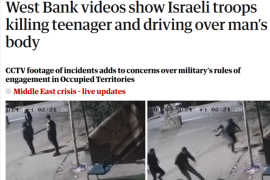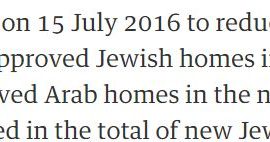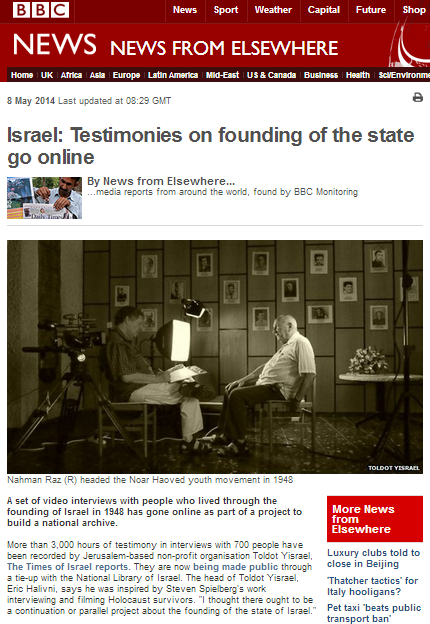In a post in 2021, we showed FA staff beclowning themselves in a report about the death Amhad Erekat, nephew of the late Saeb Erekat. FA denied that Erekat was killed after he intentionally rammed his car into a soldiers manning a checkpoint in east Jerusalem – claiming instead that he was the victim of an “extrajudicial execution”.
In addition to their absurd conclusion, FA’s agenda was revealed when, in lamenting Erekat’s death, they likened him to George Floyd, writing that “his killing illustrates both the entangled struggles of Palestinian and Black liberation, as well as the disposability of Black and indigenous bodies in hyper-militarized settler-colonies.” Further, throughout their video version of the report – narrated by pro-terror anti-Zionist activist Angela Davis – the IDF is referred to the “Israeli Occupation Forces” and Israel is called a “neo-colonial regime”.
Turning to the Guardian article about FA and Tantura, McKernan opens her piece with FA’s claims stated as a fact in the headline (“UK study of 1948 Israeli massacre of Palestinian village reveals mass grave sites”, May 25) and opening sentence:
An investigation into a massacre in a destroyed Palestinian village carried out by Israeli forces in the 1948 war surrounding Israel’s creation has identified three possible mass graves beneath a present-day beach resort.
Palestinian survivors and historians have long claimed that men living in Tantura, a fishing village of approximately 1,500 people near Haifa, were executed after surrendering to the Alexandroni Brigade and their bodies dumped in a mass grave believed to be located under an area that is now a car park for Dor Beach. Estimates have ranged from 40 to 200 people.
In recent years, a growing body of evidence for the Tantura massacre has generated significant controversy in Israel, where atrocities committed by Jewish forces in 1948 remain a highly sensitive subject: an Israeli-made documentary about what happened in the village faced widespread backlash on its release last year.
The extensive new investigation by the research agency Forensic Architecture identifies what it says is a second mass grave site in the former village of Tantura, as well as two more possible locations, in the most comprehensive research yet.
First, before addressing McKernan’s report, let’s do what the Guardian never does: place events in 1948 in context. The journalist only alludes to Israel’s war of Independence in the piece once, towards the end of her article, in noting “the events of 1948, which Palestinians call the Nakba, or catastrophe”.
However, there wouldn’t have been a single Palestinian casualty or refugee if Arab armies – supported by Palestinian leaders – hadn’t invaded the nascent Jewish state with the objective of annihilating it a mere three years after the Nazis murdered one out of every three Jews on earth.
You can not seriously discuss events relating to that time period without context about the Arabs’ malevolent decision to launch a war of aggression to rid the region of Jews, and the fact that the re-born Jewish state was fighting an entirely defensive war – a battle for its survival. Over six thousand Israelis (including many Holocaust survivors) lost their lives in that war – one percent of the entire population.
Now, returning to Tantura: First, as CAMERA has demonstrated repeatedly, the ‘Tantura massacre’ claim, which originated in a University of Haifa Master’s thesis by Teddy Katz, was debunked by veterans of the brigade who took part in the battle. They completely denied the allegations and sued Katz for slander, prompting a thorough examination of the lies and distortions orchestrated to smear the soldiers as war criminals.
For example, as CAMERA noted, in his thesis Katz had quoted a central witness called Abu Fahmi saying that the IDF had rounded up villagers, lined them up against the walls and murdered them. But after Katz was handed over the tapes of his interviews, it was clear that there no such quotes. On the contrary, Abu Fahmi had repeatedly asserted that the IDF did NOT murder the villagers after they surrendered.
Confronted with many such gross discrepancies between the quotes in his thesis and the recorded interviews, Katz insisted under oath that he had been misunderstood and that he had never believed there was a massacre.
Eminent historian Benny Morris wrote the following in Haaretz about the “massacre” claims:
It’s noteworthy that a memorandum of the Arab Higher Committee, titled “The Atrocities of the Jews,” which was sent to the UN in early July 1948, makes no mention of Tantura – another puzzling omission if a large-scale massacre had recently taken place there.
…
As I was able to discover, the archives of the UN and the Red Cross – whose officials organized and escorted the move of the Tantura refugees to Tulkarm and reported frequently to their headquarters – contain no mention of a massacre at Tantura. Does it stand to reason that among the thousand deportees, who were no longer under Jewish control, not one bothered to tell the Iraqi officers or the UN and Red Cross officials that, by the way, they had endured a horrific massacre…?
…
It’s [also] worth noting that Palestinian historiography in the decades after 1948 also did not mention a massacre at Tantura. The book deemed the Nakba bible, the six-volume “Al-Nakba” published between 1956 and 1960 by the chronicler Aref al-Aref, does not mention a massacre at Tantura. Nor does Walid Khalidi, the most important and most serious of the Palestinian historians, mention a massacre there despite devoting two-and-a-half pages to Tantura in his encyclopedic 1992 book about the lost villages, “All That Remains.”
Similarly, Mahmoud al-Yihiya Yihiya, who went into exile in Syria and in 1998 published a book called “Al Tantura” about his native village, did not mention a massacre, but rather listed the names of 52 villagers who were killed, presumably those killed in the battle and the handful of prisoners and others murdered afterward.
We reached out to Morris earlier today, and asked him to comment on FA’s claims. Though he hasn’t reviewed the report in depth, he told us the following about the alleged existence of “mass graves”:
As most historians have acknowledged, myself included, as many as 70 villagers, combatants and non-combatants, died in Tantura on 22-23 May 1948 and were buried (as were 13-14 Haganah soldiers, who were buried elsewhere).
The existence of evidence that there were mass graves proves nothing about numbers and nothing about how those buried died – and certainly adds nothing, no corroboration, to the Katz thesis and charge of an organized, systematic massacre of 200-250 villagers, for which there is no persuasive evidence.
I’m all for digging up the alleged sites and seeing what’s there.
The “massacre” claim faced what McKernan described as a “backlash” in Israel due to persuasive evidence – completely omitted by the Guardian reporter – that it never happened.





